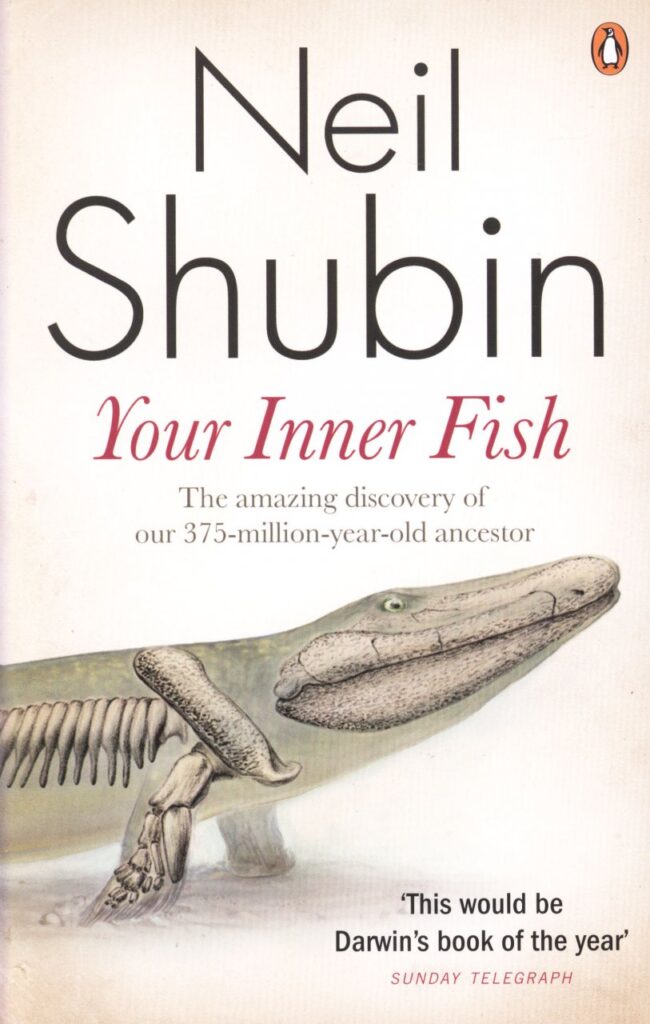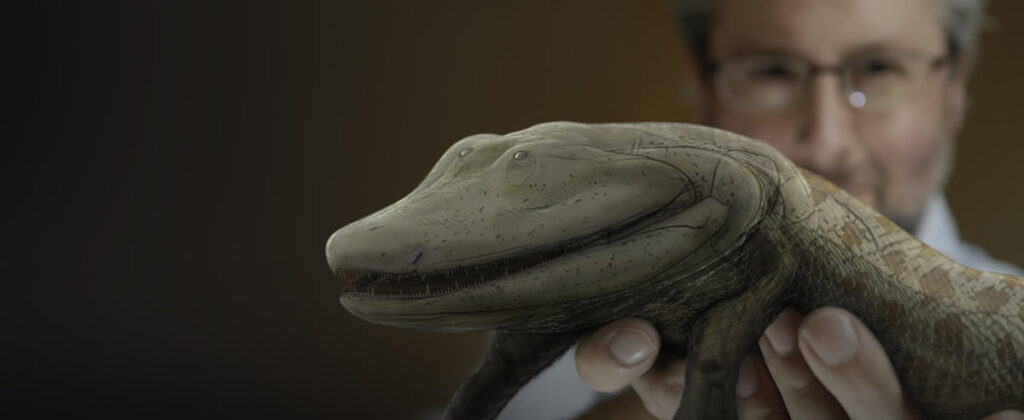
Okay, now that I have your attention, let me explain my previous sentence. Your Inner Fish is a very interesting book that explores some of the twists and turns as evolution has unfolded over hundreds of millions of years. Through these twists and turns, we got to know some of the travelers as major transitions between fish, reptiles, and mammals occurred. To name a few, Tiktaalik and Hynerpeton were some of the first fossils that were found during the many discoveries in this book. After reading multiple chapters of this book, I can see why they would suggest that fish evolved in such a way. This is a multitude of information that is given that highly suggests that fish evolved slowly throughout time.
Fish hundreds of millions of years ago looked very similar to fish that we see today. However, there was a fish, in particular, that was doing something new, something that would change the course of evolution. This fish which would later be known by the name Tiktaalik had developed bones that very closely resembled the bones in the human arm. According to author Dr. Shubin, Tiktaalik was able to do pushups due to the arm bones that were inside his fins. There were many other types of fish that proved the evolution of the arm bones way before Tiktaalik’s time, Tiktaalik was just the first fish to have all of the bones in one fin. In order to find such an interesting creature, Dr. Shubin and many others were a part of a research team that went to two different locations to find fossils. The weird thing is, they did not know what they were looking for until they stumbled upon an odd-looking fish fossil in an area close to Hyner, Pennsylvania. This fish was the first of many to contain bones from the human arm. This particular fish was the beginning of the evolution chain because the only arm bone he had was the shoulder bone. This was an amazing discovery for the team so, from there, they traveled to Ellesmere Island, Canada where they spent many months. Eventually, day after a long and tiring day, they found fish fossils that were named Tiktaalik.
In my opinion, I think that You Inner Fish was quite an interesting read. I believe that Dr. Shubin did an excellent job of describing where they went and how they found all of the fossils that led them to write the book in the first place. One of my favorite parts of the book was learning that hundreds of millions of years ago there used to be rivers and large streams that ran through what are now big cities here in the United States. Another fascinating part of Dr. Shubin’s studies involved a very detailed research project on genetic twins. In this study, German embryologists, Hans Spemann, and Hide Mangold focused on newt eggs and found that there is one specific part of the egg that splits and makes another person or animal. They began to manipulate this part of the embryo to see what would happen and the results were astounding. Dr. Spemann took a small piece of his infant daughter’s hair and tied it around the new egg which then led to the egg dividing and making a set of identical twins. Dr. Mangold was known as a largely successful woman when studying this type of research. Her experiments involved cutting a small piece of an egg (the egg was one-sixteenth of an inch in diameter!) and attaching it to another egg to form a perfect set of twins. I believe this was one of the most interesting parts of the book and it is one of the reasons it kept me reading. Another reason that baffled me was when the author discussed the way that mammals smell things. He described that there are thousands of nerves behind the nose and eyes that have multiple receptors on them. Molecules that contain smells attach to these receptors and are transformed into scents once registered by the brain. There are millions of smells that humans can detect and all of these nerves work together to help the brain decide which scent is in the air around us. One amazing fact that was stated in the book is that over three percent of our entire human genome is dedicated, specifically, to different smells around the world!
One of the things I found difficult about this book was how long it took the author to describe his findings. I feel his focus was split between giving lengthy background stories and giving readers as much detailed information as he could pack into a page. Because of this, it felt at times he would lose track of what he was trying to convey. It is a good thing to give a lot of detail, but not so much that the reader gets confused. He was very focused on giving intricate details, which is a good thing, but it was so detailed that I lost interest multiple times because it felt like too much to read in order to get the needed information. Another thing that I disliked about the book is the chapters jumped around a lot. At one point he would be talking about going on a research expedition, discussing what he found, and then would jump to talking about the parts of the nose and the ears. I understand that this was necessary for later information, but instead of dedicating whole chapters to this information, he could have explained what he was talking about as he went.
Your Inner Fish was an intriguing, informative, adventure through the evolution of fish to mammals with multitudes of information to back the findings of their research expeditions. This book is a good source of information if one is studying the evolution of fish, reptiles, or monkeys, even learning about embryonic experiments, or just discovering interesting facts about how people hear or smell things.
Written by Kailee Henderson
Kailee Henderson is a cohort 6 SI Bridges to the Baccalaureate scholar. She joined the program when she was an undergraduate at Shawnee Community College. In 2020, she transferred to Southern Illinois University Carbondale where she is currently majoring in Radiological Science. Her interests include gardening, where she enjoys planting and watching the flowers bloom.

